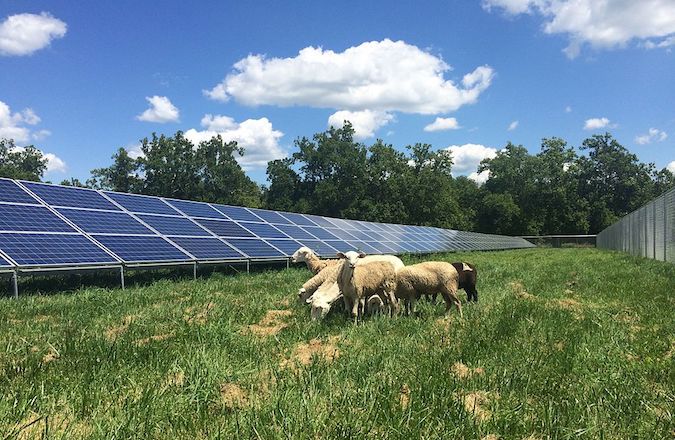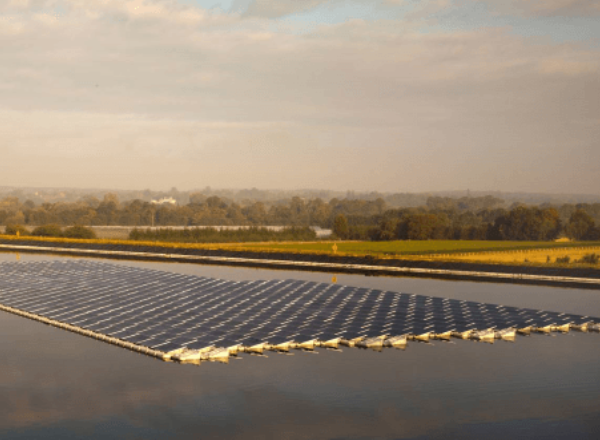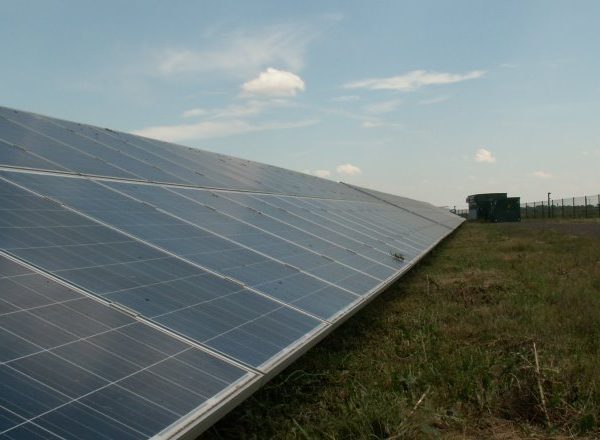You herd it here first, the land that makes an optimal area for livestock is often also an ideal spot for solar farms. They’re both vast, rather flat plots of land which receive ample levels of sun. Increased solar production benefits the environment, but it may come at the expense of agriculture production. That is why there is a growing appeal in discovering ways to bring together the solar and agricultural worlds.
Bring Out The Sheep!
Some farmers are opting to flock together with solar producers to gain the maximum benefits of the land. The solar producers pay farmers to ship their sheep over to their operations, and the sheep tend to the weeds and other plants, stopping them from growing to the point they block the sun from reaching the panels. It’s a win-win-win situation; the sheep get fed, the farmers get paid and the solar producers don’t have to use mowers or weed whackers to keep the vegetation under control.
Figure 1: Solar array in the Antioch College South Campus, near the farm. Sheep included. [5]
In 2014, The Building Research Establishment (BRE) published the “Agricultural Good Practice Guidance for Solar Farms” which describes experience and principles of good practice for the management of small livestock in solar farms. The document quotes sheep grazing as being one of the main livestock utilised in “Solar Grazing” and boasts the benefits of:
- Fossil Fuel free land mowing and maintenance
- Biodiversity growth
- Increased productivity.
Although the benefits are high, some are not so welcoming of the idea.
Are They Pulling The Wool Over Our Eyes?
Fields that formerly grew wheat, barley, and other crops are now being converted to harvest sunshine across the UK. It’s not unexpected that the topic is dividing the countryside. Developers are currently targeting around 11,000MW of new ground-mounted solar panels, which will double the current capacity. To put that into perspective, every MW of energy requires roughly three to four acres of solar panels, meaning that the current target would see 40,000 acres of land covered. As a result, there is debate among farmers about whether this is the best long-term use of land. Martin Lines, who grows cereal crops in Cambridgeshire argues that “there is no focus around long term food security or meeting the needs of UK citizens from our landscape.”
What’s Happening Across The Pond?
Between 2019 and 2020, Oregon State University in the USA conducted a study into the use of lamb grazing and solar energy production on the same land. Findings included:
- The lambs gained almost the same amount of weight across the land used for solar and typical farming land.
- The daily water consumption of the lambs in the two pasture types in spring 2019 were similar during early spring, but lambs in open pastures consumed more water than those grazed under solar panels in the late spring period. There was no difference observed in the water intake of the lambs in spring 2020.
- Over the two years, solar pastures produced 38% less forage than open pastures.
- Overall, the return from grazing was $1,046 (£856) per hectare per year in open pastures and $1,029 (£842) per hectare per year in pastures with solar panels.
The report states that the overall return is roughly the same, and that doesn’t consider the energy that is being produced by the solar panels.
Time Wool Tell!
There are arguments to be made, both for and against the influx of agricultural land being transformed into solar farms. But with the rise in “Solar Grazing”, hopefully landowners won’t be so sheepish.
About Pager Power
Pager Power undertakes technical assessments for developers of renewable energy projects and tall buildings. For more information about what we do, please get in touch.
References
[1] Johnson, D., 2022. When it comes to solar farms, sheep are great groundskeepers. [online] Ars Technica.
[2] BRE (2014) Agricultural Good Practice Guidance for Solar Farms. Ed J Scurlock
[3] The Telegraph. 2022. How farming solar panels became more profitable than crops. [online]
[4] The Telegraph. 2022. How farming solar panels became more profitable than crops. [online]
[5] Gabelglesia (August 2015) from WikiCommons. Last accessed on 16th May 2022. Available at: https://commons.wikimedia.org/wiki/File:Antioch_College_solar_sheep.JPG
[6] Andrew, A., Higgins, C., Smallman, M., Graham, M. and Ates, S., 2021. Herbage Yield, Lamb Growth and Foraging Behavior in Agrivoltaic Production System. Frontiers in Sustainable Food Systems, 5.




